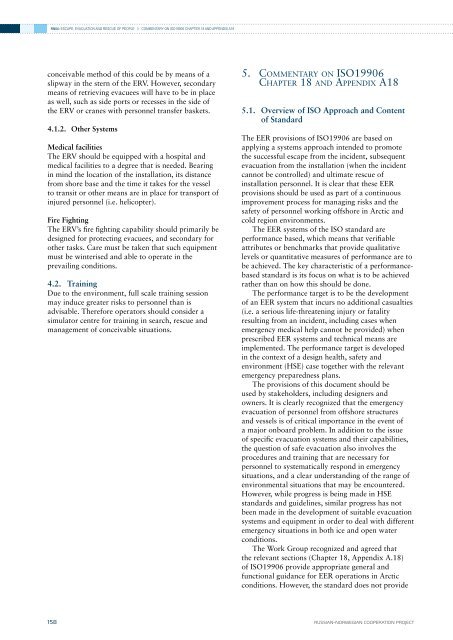phase 4 report - DNV
phase 4 report - DNV
phase 4 report - DNV
Create successful ePaper yourself
Turn your PDF publications into a flip-book with our unique Google optimized e-Paper software.
RN04: ESCAPE, EVACUATION AND RESCUE OF PEOPLE // Commentary on ISO19906 Chapter 18 and Appendix A18conceivable method of this could be by means of aslipway in the stern of the ERV. However, secondarymeans of retrieving evacuees will have to be in placeas well, such as side ports or recesses in the side ofthe ERV or cranes with personnel transfer baskets.4.1.2. Other SystemsMedical facilitiesThe ERV should be equipped with a hospital andmedical facilities to a degree that is needed. Bearingin mind the location of the installation, its distancefrom shore base and the time it takes for the vesselto transit or other means are in place for transport ofinjured personnel (i.e. helicopter).Fire FightingThe ERV’s fire fighting capability should primarily bedesigned for protecting evacuees, and secondary forother tasks. Care must be taken that such equipmentmust be winterised and able to operate in theprevailing conditions.4.2. TrainingDue to the environment, full scale training sessionmay induce greater risks to personnel than isadvisable. Therefore operators should consider asimulator centre for training in search, rescue andmanagement of conceivable situations.5. Commentary on ISO19906Chapter 18 and Appendix A185.1. Overview of ISO Approach and Contentof StandardThe EER provisions of ISO19906 are based onapplying a systems approach intended to promotethe successful escape from the incident, subsequentevacuation from the installation (when the incidentcannot be controlled) and ultimate rescue ofinstallation personnel. It is clear that these EERprovisions should be used as part of a continuousimprovement process for managing risks and thesafety of personnel working offshore in Arctic andcold region environments.The EER systems of the ISO standard areperformance based, which means that verifiableattributes or benchmarks that provide qualitativelevels or quantitative measures of performance are tobe achieved. The key characteristic of a performancebasedstandard is its focus on what is to be achievedrather than on how this should be done.The performance target is to be the developmentof an EER system that incurs no additional casualties(i.e. a serious life-threatening injury or fatalityresulting from an incident, including cases whenemergency medical help cannot be provided) whenprescribed EER systems and technical means areimplemented. The performance target is developedin the context of a design health, safety andenvironment (HSE) case together with the relevantemergency preparedness plans.The provisions of this document should beused by stakeholders, including designers andowners. It is clearly recognized that the emergencyevacuation of personnel from offshore structuresand vessels is of critical importance in the event ofa major onboard problem. In addition to the issueof specific evacuation systems and their capabilities,the question of safe evacuation also involves theprocedures and training that are necessary forpersonnel to systematically respond in emergencysituations, and a clear understanding of the range ofenvironmental situations that may be encountered.However, while progress is being made in HSEstandards and guidelines, similar progress has notbeen made in the development of suitable evacuationsystems and equipment in order to deal with differentemergency situations in both ice and open waterconditions.The Work Group recognized and agreed thatthe relevant sections (Chapter 18, Appendix A.18)of ISO19906 provide appropriate general andfunctional guidance for EER operations in Arcticconditions. However, the standard does not provide158RUSSIAN–NORWEGIAN COOPERATION PROJECT






![Risk Based Pipeline Integrity Management [Compatibility Mode] - DNV](https://img.yumpu.com/50424229/1/190x146/risk-based-pipeline-integrity-management-compatibility-mode-dnv.jpg?quality=85)









